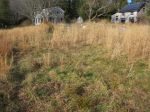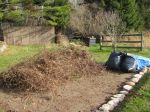A dandelion in bloom says the bees could be getting ready to swam. But not when the dandelion blooms in November.
Forsythia blooms when its time to put corn gluten on the grass. But not when the forsythia blooms in November.
Rosa ragusa is still blooming at the beach. And Daucus carota, Queen Anne’s lace, is in bloom in the south east corner of the meadow. See the photo.
The meadow pops with grasshoppers. A dragonfly caught bugs while I snipped nearby. A white moth flew out of the dry thatch I removed. I was stung twice but not by the bees, a few of whom were out foraging. In the still warm soil, the worms, always sluggish, seem no less content than when the sun is high in the sky.
The color in my cheeks is not from the cold. Were it not for fear of ticks, a short-sleeved shirt would be sufficient warmth for meadow work.






